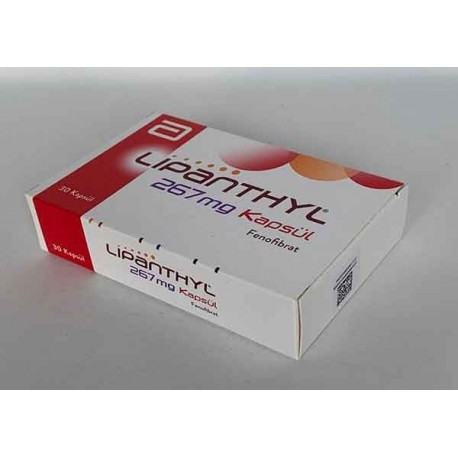 View larger
View larger Lipanthyl (Fenofibrate, Generic Tricor, Triglide) Tablets&Capsules
New product
BUY MORE PAY LESS
| Quantity | Discount | |
|---|---|---|
| 2 | 5% | |
| 3 | 10% | |
| 4 | 15% | |
| 5 | 20% |
Volume discounts
| Quantity | Discount | You Save |
|---|---|---|
| 2 | 5% | Up to $5.20 |
| 3 | 10% | Up to $15.60 |
| 4 | 15% | Up to $31.20 |
| 5 | 20% | Up to $52.00 |
More info
Active ingredient
Each tablet contains 160 mg of fenofibrate.
Excipients
Contains sodium lauryl sulfate, bovine lactose monohydrate, povidone, crospovidone, microcrystalline cellulose, colloidal anhydrous silica, sodium stearyl fumarate, opadry (polyvinyl alcohol, titanium di oxide (El 71), talc, soy lecithin, xanthan gum).
2. What is LIPANTHYL and what is it used for?
LIPANTHYL 160 mg, white, fdm coated tablet with "160" printed on one side and "Foumier" logo on the other side. It contains 30 tablets in its package.
LIPANTHYL belongs to a group of drugs commonly known as 'fibrates'.
These medications are used to lower the levels of fat (lipid) in the blood. Fats known as triglycerides are examples of this.
LIPANTHYL is used in combination with a low-fat diet and other non-ubiquitous applications such as exercise and weight loss to lower the triglyceride level in the blood. In some cases where LIPANTHYL cannot be controlled with a type of medicine called statin, it is used in addition to statin-type drugs to reduce blood fat levels.
I
Different levels of diabetic retinopathy (eye fundus disorder due to diabetes) can be seen in patients with type 2 diabetes (diabetes). This is a problem that can lead to impaired vision or loss of vision in diabetic patients. LIPANTHYL has been shown to slow the progression of diabetic retinopathy in patients with high triglyceride elevation and non-proliferative (not advanced stage, ie non-proliferative) diabetic retinopathy. (LIPANTHYL 160 mg does not replace proper control of blood pressure, blood sugar and lipid levels in the blood in slowing the progression of diabetic retinopathy.)
3.How to use LIPANTHYL?
Use this medicine as your doctor or pharmacist has told you. If you are not sure, consult your doctor or pharmacist.
Instructions for appropriate use and dose / frequency of administration
The starting and continuation dose of LIPANTHYL for adults is a tablet containing 160 mg fenofibrate once a day. Patients who are currently taking LIPANTHYL 200 M Capsules can switch to LIPANTHYL 160 mg Tablet once a day.
• Lipid disorder requires long-term treatment. Do not stop your medication unless your doctor informs you.
Your doctor will tell you how long your treatment will take with LIPANTHYL.
Application route and method
• LIPANTHYL is for oral use.
• Take it with food as it will have less effect if you take it while your stomach is empty. Swallow the tablet whole with a glass of water.
• Do not crush or chew the tablet.
• Take the tablets at the same time every day, between a meal, as prescribed by your doctor.
Different age groups
Use in children
Use in the elderly
Use in the elderly:
The usual adult dosage is recommended for elderly patients without renal impairment.
Special use cases
Kidney failure:
LIPANTHYL should not be used in patients with severe renal insufficiency. It is not recommended for use in patients with mild to moderate renal impairment. Dosage should be reduced in patients with renal impairment. In this case, consult your doctor or pharmacist.
Liver failure:
LIPANTHYL should not be used in patients with hepatic insufficiency.
If you have the impression that the effect of LIPANTHYL is too strong or too weak, talk to your doctor or pharmacist.
If you use more LIPANTHYL than you should
If you have used LIPANTHYL more than you should, or if someone else has used your medicine, consult your doctor or pharmacist immediately or contact the emergency department of the nearest hospital.
4. What are the possible side effects?
Like all medicines, people who are sensitive to the ingredients of LIPANTHYL may have side effects.
Side effects are classified as shown in the following categories:
Very common: It can be seen in at least 1 of 10 patients.
Common: less than 1 in 10 patients, but more than 1 in 100 patients.
Uncommon: less than 1 in 100 patients, but more than 1 in 1000 patients. Rare: Less than 1 of 1000 patients, but more than 1 of 10,000 patients.
Very rare: Less than 1 of 10000 patients can be seen.
Unknown: Cannot be estimated from the available data
If any of the following occur stop using LIPANTHYL and IMMEDIATELY inform your doctor or go to the nearest emergency department
Unusual:
• Cramps or muscle pain, tenderness, or weakness - these may be signs of muscle inflammation or damage. Although these problems are very rare, they can lead to kidney damage and even death.
• Abdominal pain - could be a sign that your pancreas is inflamed (pancreatitis).
• Chest pain or a feeling of breathlessness - these may be signs that there may be blood clots in the lungs (pulmonary embolism).
• Pain, redness or swelling in the legs - these may be signs of blood clots in the leg (deep vein thrombosis).

